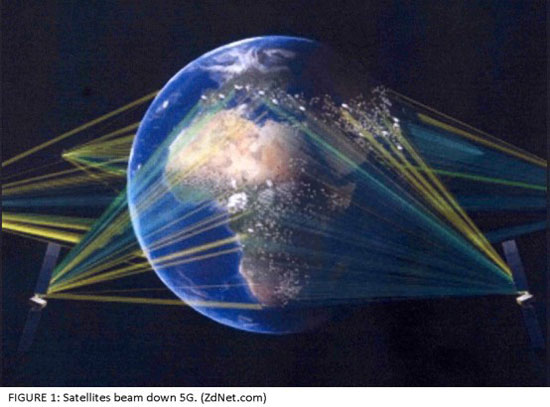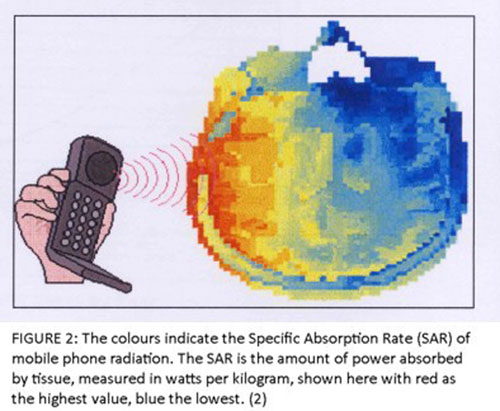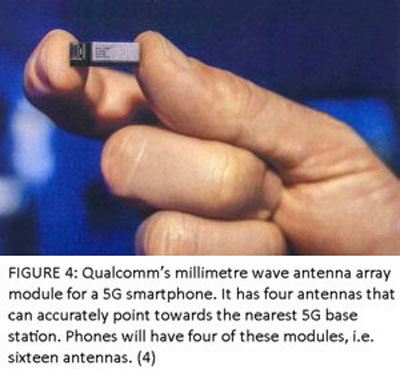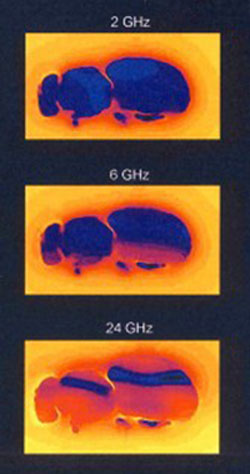5G From Space: ‘Not One Inch Of The Globe Will Be Free Of Radiation’ (1)
By Jeremy Naydler, PhD
April 6, 2019
In November of 2018, the United States Federal Communications Commission (FCC) authorised the rocket company SpaceX, owned by the entrepreneur Elon Musk, to launch a fleet of 7,518 satellites to complete SpaceX’s ambitious scheme to provide global satellite broadband services to every corner of the Earth.

The satellites will operate at a height of approximately 210 miles, and irradiate the Earth with extremely high frequencies between 37.5 GHz and 42 GHz. This fleet will be in addition to a smaller SpaceX fleet of 4,425 satellites, already authorised earlier in that year by the FCC, which will orbit the Earth at a height of approximately 750 miles and is set to bathe us in frequencies between 12 GHz and 30 GHz. The grand total of SpaceX satellites is reaching just under 12,000.
There are at present approximately two thousand fully functioning satellites orbiting the Earth. Some beam down commercial GPS (or “SatNav”), some provide TV, some provide mobile phone services, and some bounce radar back and forth to produce images for meteorologists and military surveillance. The Earth is thus already comprehensively irradiated from outer space.
But the new SpaceX fleets will constitute a massive increase in the number of satellites in the skies above us, and a correspondingly massive increase in the radiation reaching the Earth from them. The SpaceX satellite fleet is, however, just one of several that are due to be launched in the next few years, all serving the same purpose of providing global broadband services. Other companies, including Boeing, One Web and Spire Global are each launching their own smaller fleets, bringing the total number of projected new broadband satellites to around 20,000 – every one of them dedicated to irradiating the Earth at similar frequencies (fig. 1).

Why is there this sudden flurry of activity? The new satellite fleets are contributing to a concerted global effort to “upgrade” the electromagnetic environment of the Earth. The upgrade is commonly referred to as 5G, or fifth generation wireless network. It has become customary in tech circles to talk about the introduction of 5G as involving the creation of a new global “electronic ecosystem”. It amounts to geo-engineering on a scale never before attempted. While this is being sold to the public as an enhancement of the quality of video streaming for media and entertainment, what is really driving it is the creation of the conditions within which electronic or “artificial” intelligence will be able to assume an ever greater presence in our lives.
The introduction of 5G will require hundreds of thousands of new mini mobile phone masts (also referred to as “base stations”) in urban centres throughout the UK, and literally millions of new masts in cities throughout the rest of the world, all emitting radiation at frequencies and at power levels far higher than those to which we are presently subjected.
These new masts are much smaller than the masts we currently see beside our motorways and on top of buildings. They will be discreetly attached to the side of shops and offices or secured to lampposts. The 20,000 satellites are a necessary supplement to this land-based effort, for they will guarantee that rural areas, lakes, mountains, forests, oceans and wildernesses, where there are neither buildings nor lampposts, will all be incorporated into the new electronic infrastructure. Not one inch of the globe will be free of radiation.
Given the scale of the project, it is surprising how few people are aware of the enormity of what is now just beginning to unfold all around us. Very few people have even heard about the 20,000 new satellites that are due to transform the planet into a so-called “smart planet”, irradiating us night and day. In the national media, we do not hear voices questioning the wisdom, let alone the ethics, of geo-engineering a new global electromagnetic environment.
But the question we should ask is whether we also want increasingly intense exposure of the natural environment and all living creatures, including ourselves, to more and more electromagnetic radiation.
Instead, there is a blithe acceptance that technology must continue to progress, and the presence in our lives of increasingly “smart” machines and gadgets that each year become cleverer and more capable is an inevitable part of this progress. And who doesn’t want progress? Almost everyone loves their sleek and seductively designed phones, pads and virtual assistants, and regards them as an indispensible part of their lives.
But the question we should ask is whether we also want increasingly intense exposure of the natural environment and all living creatures, including ourselves, to more and more electromagnetic radiation. Is it likely that this does not entail any adverse health consequences, as both government and industry claim? If the electromagnetic waves that connect our smartphones to the Internet travel through brick, stone and cement, then what happens when these same waves encounter our bodies?
Be assured that they do not just bounce off us! They travel into the human body. The degree to which they are absorbed can be precisely measured in what is called the Specific Absorption Rate, expressed in Watts per kilogram of biological tissue. When we fill our houses with Wi Fi, we are irradiating our bodies continuously. When we hold a smartphone to our ear, electromagnetic waves irradiate our brains (fig.2). Do we really believe this could be completely harmless?

Waves and Frequencies
At present, mobile phones, smartphones, tablets, most Wi Fi and so on all operate at under 3 GHz in what is called the “microwave” region of the electromagnetic spectrum. If you could see and measure their wavelengths, you would find that they are many centimetres (or inches) long. A smartphone operating at 800 MHz, for example, sends and receives signals with wavelengths of 37.5 centimetres (just under 15 inches). Operating at 1.9 GHz, the wavelengths are 16 centimetres (just over 6 inches). Wi Fi uses the 2.4 GHz frequency band with 12 centimetre wavelengths (just under 5 inches long).
The introduction of 5G will entail the use of considerably higher frequencies than these, with correspondingly shorter wavelengths. Above 30 GHz, wavelengths are just millimetres rather than centimetres long. The millimetre waveband (from 30 GHz to 300 GHz) is referred to as Extremely High Frequency, and its wavelengths are between 10 millimetres and 1 millimetre in length. Up to the present time, Extremely High Frequency electromagnetic radiation has not been widely propagated, and its introduction marks a significant step change in the kind of electromagnetic energy that will become present in the natural environment (fig.3).

The reason why millimetre waves are to be used for 5G is that much larger bands of spectrum are available in the Extremely High Frequencies than at lower frequencies. This means that there can be much broader “bandwidth”. Broader bandwidth means that larger quantities of data can be transferred and the speed of transfer of the data will be significantly faster.
One of the effects of this is that it reduces what is called “latency”, or time-lag, in the system, so it improves the quality of video streaming. But in so doing, it also enables a greater seamlessness between the data accessible from virtual sources and our perceptions of objects in the real world, as is required, for example, in Augmented Reality applications. Greater seamlessness means that we more effortlessly inhabit the natural and the electronic worlds as if they were a single reality.
One of the technical problems of using frequencies in the millimetre region of the spectrum is that, because the waves carrying the data are so tiny, being only millimetres long, they are less able to pass through physical barriers, like walls and trees, than are the longer waves of lower frequencies. This is why it is necessary to have so many more new phone masts or “base stations”. They will need to be spaced at 100 metres apart in cities because beyond this distance their signals weaken and are therefore less able to penetrate buildings, and connect with the devices inside. As well as being more closely spaced, the 5G base stations will operate at much higher power than current phone masts, in order to ensure that the signals are sufficiently strong.
Because the wavelengths are so much smaller, the antennas transmitting and receiving them will also be much smaller than those of current phone masts and electronic devices. A single 5G transmitter/receiver will have a large number of tiny antennas, grouped together in one unit. An array of just over a thousand such antennas measures only four square inches, so will easily fit into a small base station on a lamppost, while the smartphone in your pocket will probably have sixteen (fig.4).

But it also means that any living creature that gets in the way of such a concentrated beam will be subjected to a powerful dose of extremely high frequency radiant electricity.
Both 5G satellites and 5G land-based masts will use a system called the “phased array”. In the phased array, groups of antennas are co-ordinated to radiate pulses in a specific direction and in a specified time sequence. This allows a concentrated beam of radio waves to be exactly aimed at designated targets, to enable signals to be sent or received. Because the beams are concentrated in this way, this adds to their power, which means they are able more easily to penetrate buildings.
But it also means that any living creature that gets in the way of such a concentrated beam will be subjected to a powerful dose of extremely high frequency radiant electricity. A study published earlier this year demonstrated that certain insects, because of their small body-size, are particularly vulnerable to the millimetre waves of the higher frequencies to be utilised by 5G (fig. 5). Other studies have shown that bacteria and plants are also vulnerable, and so also (as one might expect) are the skin and the eyes of animals including, of course, human beings.

Figure 5: Illustration of the absorption of Radio Frequency electromagnetic radiation in the Honey Bee. At currently used frequencies between 2 GHz (top) and 6 GHz (middle), the wavelength is relatively large compared to the insect. But at 24 GHz, (bottom) the wavelength is closer to the insect’s size and the radiation penetrates further.
As well as its ability to concentrate power in focused beams, phased array technology has a further complicating factor. Either side of the main beam, the time intervals between the pulses are different from the time intervals between those of the main beam, but they may overlap each other in such a way as to produce extremely rapid changes in the electromagnetic field. This can have a particularly detrimental effect on living organisms, because instead of the radiation decaying when it is absorbed into living tissue, it can be re-radiated within the body.
The moving charges streaming into the body effectively become antennas that re-radiate the electromagnetic field and send it deeper into the organism. These re-radiated waves are known as Brillouin precursors, named after the French physicist Leon Brillouin, who first described them in 1914. Research suggests that they can have a significant and highly detrimental impact on living cells.
The Un-reassuring Assurances of Government and Industry
The Government body charged with protecting public health, Public Health England, advises us that there is no convincing evidence that Radio Frequency radiation (which radio, television, mobile phones, smartphones and 5G all use) has any adverse health effects on either adults or children.
It was like giving a blank cheque to the telecommunications industry to move on into the higher frequencies, without any heed for the consequences.
This advice is based on the recommendations of a supposedly independent body called AGNIR (Advisory Group on Non-Ionising Radiation), which produced a report in 2012 on the safety of Radio Frequency radiation. The report stated that there was a lack of “convincing” and “conclusive” evidence for any adverse health effects. It was like giving a blank cheque to the telecommunications industry to move on into the higher frequencies, without any heed for the consequences.
It turns out that far from being independent, AGNIR has a high proportion of members with blatant conflicts of interests, and their report distorted or simply left out of account evidence that should have compelled them to reach the opposite conclusion to the one they arrived at. In a forensic analysis of the report, the environmental health researcher, Sarah Starkey, makes it clear that only a wilful disregard of the available scientific evidence could explain its internal contradictions and apparent incompetence.
And yet it is the basis of current UK Government policy, allowing government to roll out 5G without so much as even a nod towards the need for prior health and safety assessment. Health and safety simply do not feature in Government thinking, despite a veritable mountain of literally thousands of research papers demonstrating adverse health effects, which continues to grow at the rate of roughly 350 per year, on average practically one every day.
One of the reasons for ignoring this evidence in the hell-for-leather dash to create the 5G electronic ecosystem is the conviction in government circles that, unless we introduce it immediately, we will be “left behind” and our economic growth and competitiveness will be put at risk. There is simply no time to consider the possible health consequences.
Read the second part of the article
yogaesoteric
January 10, 2019
